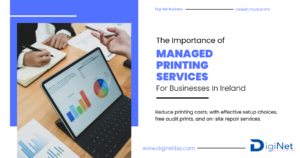
Using Managed Print Services To Enhance Employee Productivity – Here is How MPS Can Increase Efficiency and Productivity With A Printer Fleet
Managed print services (MPS) have become a popular solution for businesses seeking to streamline their document management process. By outsourcing the management of printing devices, businesses aim to reduce costs, improve workflows, and increase security. However, choosing a managed print solutions provider is an important decision that should not be taken lightly. This is because while the right MPS provider can be a valuable asset, the wrong provider might not make much impact on your business operations.
It is a well-known fact that employees are the core of any organization and the importance of employee productivity cannot be overstated. This is one of the main factors that can directly impact an organization’s bottom line and profit margins as well. According to a report by Gallup, disengaged employees cost U.S. companies between $450 and $550 billion annually in lost operational and productivity-related issues.
Due to the importance of positively impacting employee productivity, it is important to have a thorough understanding of what Managed Print Services encompasses and how it can help your business. Do these services offer you only cost reduction through workflow improvements or are there many more features of these efficiency and productivity solutions?
While little research has been conducted on the impact of MPS on employee productivity, we have created this article to explore this topic in detail. The following paragraphs will analyze existing literature and conduct a case study on this crucial topic.
Cost Savings and Higher Profits Through Enhanced Employee Performance
A good leader is nothing lesser than the sailor of a ship, steering through turbulent waters to keep his crew safe. The same logic can be used for employee-centric businesses that work hard to steer their employees through challenges and obstacles to achieve unanimous success. One of the key factors that determine a company’s success is employee productivity, while the other is the amount of time it takes to implement a successful strategy.
Employee productivity directly affects the quality, quantity, and timeliness of work produced by an organization as when the employees of any firm are productive, they can complete the given tasks in a shorter time frame. This directly increases profitability and the revenue generated by the business.
Top companies and their leaders, will often state that the benefits of high employee productivity extend beyond financial gains. A well-placed and content employee can contribute to a positive work culture as well, which in turn motivates other employees to feel valued and motivated. A higher job satisfaction level, lower turnover rates, and increased employee engagement are all important factors for sustainable business growth and a positive brand image in the current competitive market.
An Overview of The Environmental Impact of MPS To Extended to Improve Productivity Of Employees Through Tailor-Made Print Fleet Strategies
More often than not, organizations invest significant time and resources in training their employees through performance management programs to optimize employee productivity. This is because employee productivity is a crucial factor in ensuring that businesses achieve their objectives as well are considered a sought out place to work for potential employees.
Managed Print Services (MPS) create a positive environmental impact which has a significant impact on employee productivity. MPS is a comprehensive solution that manages an organization’s print environment from workflow, user profiles, print security, hardware, software solutions, supplies, on-site repair service, and remote technical support.
The primary objective of MPS is to create a seamless and optimized print infrastructure. This is often done by reducing printing costs, improving document security, enhancing document workflow efficiency, and promoting sustainable printing practices for multiple users who work in the company.
Several studies have shown that MPS can help improve employee output by streamlining printing processes and reducing the burden of printer-related issues on their work staff.
An excellent example is, MPS can automate routine printing tasks such as ordering supplies or troubleshooting printer issues. This automation can save your work staff from time wastage in minor tasks. Additionally, it will give them the needed tools to focus on more strategic tasks that contribute to organizational goals.
Additionally, MPS can ensure that authorized staff can access document workflows by enabling remote access from anywhere at any time using mobile devices or cloud computing solutions.
Existing Literature On MPS and Employee Productivity
The implementation of Managed Print Services (MPS) in organizations has been a topic of interest for researchers investigating its impact on employee output. Various research programs have explored the relationship between MPS and employee output. They have also highlighted both the positive and negative effects of using printer fleet solutions.
Some studies suggest that MPS can enhance employee productivity by reducing the time spent on printing-related tasks such as replacing copier and toner cartridges, manually setting printers, and fixing printers for minor issues.
A few studies have indicated that employees may experience decreased productivity due to changes in printing processes, however, this can be overcome through a transition training program.
A study conducted by Kyocera Document Solutions Europe reported that MPS can lead to significant improvements in the final output and outcome of a workforce in any sector. This study indicated that by using MPS, businesses can observe a 30% reduction in the amount of time employees spend on manual printing tasks. Additionally, the study showed that MPS can significantly enhance document security, streamline workflows, and reduce downtime caused by print management issues.
Another survey conducted by Quocirca indicated that 60% of the participants believed that MPS had positively impacted their organization’s overall output.
A few studies indicated the potential negative impacts of MPS on employee productivity in regards to the placement of the printer, accessibility to the device, and being asked to use new equipment that the employees are not trained to operate.
In addition to understanding the benefits of MPS, it is crucial for companies to train their employees about the transition. Additionally, firms should help their work staff overcome any barriers to using MPS as a new and improved solution for their printing needs.
A Comprehensive Case Study On The Impact Of MPS On Employee Output
A case study was recently conducted to understand the impact of Managed Print Services (MPS) on employee output. The focus group of the study was a mid-sized organization that had recently implemented MPS. The data was collected through surveys and interviews with employees, as well as a print data analysis.
The results unanimously indicated that MPS had a positive impact on employee output through the following benefits that MPS offered the staff.
- MPS ensured a reduced amount of time was spent on printing-related tasks.
- A series of tasks were automated by MPS, these tasks included ordering supplies, troubleshooting printer issues, and maintaining equipment. This ensured that the staff could focus more on their core tasks and increased their overall output.
- The MPS system that was installed on-site provided faster and more reliable printing services, reducing the wait time for print jobs which ensured a more streamlined printing process.
- There was a noticeable improvement in both employee satisfaction and the team’s morale. The team reported fewer frustrations with printing-related issues. They also were thankful for the improved printing services. This ensured that the team felt more motivated to complete their work and were more engaged in the tasks allotted to them.
The key findings were that MPS can positively impact employee output by saving time, improving productivity, and increasing job satisfaction. Moreover, the improved printing services led to higher levels of job satisfaction among employees which ultimately resulted in greater motivation towards task completion due to a streamlined printing process.
Key Takeaways And Recommendations For Businesses Considering MPS
Businesses that are considering implementing MPS should take into account the key takeaways and recommendations mentioned here.
- MPS can have a positive impact on employee output through automated and streamlined printing tasks and workflows, remote access, and on-site support.
- By hiring a reliable third-party printing partner companies do not have to worry about hiccups along the process. Companies can instead focus on training their staff on how to make the most of the MPS services provided on-site. A reliable MPS partner should have experience and a good reputation as well as a proven track record of high-quality services. Reliable print management vendors such as Digi Net provide tailor-made solutions, flexible choices, and offers that work in favor of their clients.
- Print fleet solutions work best when there is open and ongoing communication between the firm and the MPS vendor. Any changes, updates, and business policies that might affect the MPS vendor should be communicated to ensure a smooth and long-standing working relationship.
Frequently Asked Questions About Print Management Strategies in Ireland
What Are The Typical Costs Associated With Implementing Managed Print Services?
Implementing managed print services does not necessarily have to be a costly endeavor for businesses. A series of variable factors contribute to the final expense. A recent study conducted by Quocirca found that the average cost of implementing managed print services for a small business is approximately £6,000 per year.
The indicated cost was inclusive of hardware upgrades, software licenses, and ongoing maintenance fees. The final cost will depend on the size of the organization and its specific printing needs.
While the initial investment may seem steep, businesses can notice significant savings in terms of reduced printing costs and increased efficiency in as less as a few months to a year.
How Long Does It Typically Take For Businesses To See An Improvement In Employee Productivity After Implementing Mps?
The final result will depend on the sector, and the team if the team is being trained to transition to MPS. While a few studies have reported an increase in productivity within 6-12 months of implementation, many others have seen immediate improvements.
While it can take a short while to see an improvement in employee productivity, keep in mind the size of the company, the complexity of the MPS implementation process, and if an MPS transition program is in place, will affect the final turnaround time.
An MPS transition program can be a simple step-by-step process of the changes, how to reach the MPS vendor for the needed solutions, and who to contact during downtime. How to use workflows for document printing and how to create user profiles as well as how to access the data remotely can be a positive addition to the training program.
Can MPS be Customized To Meet The Specific Needs Of Different Types Of Businesses And Industries?
Yes, most Managed Print Service Providers offer tailor-made strategies. The factors used during the evaluation include the type of printing equipment and an analysis of print-related expenses. The MPS vendor will then develop a well-thought strategy that aligns with the organization’s goals.
The goal of hiring a third-party vendor is to identify areas where they can streamline their printing processes, reduce waste, and optimize their overall print environment. An excellent example of this is, that healthcare organizations require secure printing solutions that comply with HIPAA regulations while manufacturing companies need robust document management systems to support their production processes.
A tailor-made strategy can ensure that your business can improve efficiency and productivity while reducing costs associated with printing operations.
How Do Businesses Measure The Impact Of MPS On Employee Output?
Three common methods are used to evaluate the impact of MPS on your staff’s output.
The first is to examine the reduced time spent by your team while handling printing-related issues, such as document printing, placing supply orders, or troubleshooting equipment.
The second is to track the increase in workflow efficiency resulting from seamless print processes and automated tasks.
The third is to use the power of employee satisfaction surveys to gauge their overall experience with MPS implementation and the ease of the transition.
How Can You Increase Overall Productivity Using MPS?
It is a fact that MPS can help your business by more than just reducing toner and cartridge costs. However, there are costs associated with implementing MPS that should be kept in mind.
Most businesses typically see an improvement in employee productivity within a few months, while some might see results in as little as a few weeks.
Reliable MPS vendors offer strategies customized to meet the specific needs of different types of businesses and industries. Reliable vendors offer enhanced productivity solutions by first offering a free Print Audit, which is an analysis of your current print expenditure and existing office equipment.
If you are concerned about data security concerns and the potential for downtime if the system experiences technical issues, then choosing a reliable vendor such as Digi Net might be in your best interest. We offer on-site service and repairs, and we ensure that you get these services in a quick and prompt manner. We also offer a complimentary print assessment and print audit to make tailor-made and scale as you grow plans for your company.
Contact us today to know how we can improve your total employee output while lowering operational costs and increasing efficiency.




